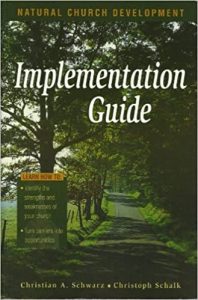THE PROCESS-DRIVEN STRATEGY
A clear representative of the process-driven strategy for church health is Rick Warren’s Purpose Driven Church (PDC) model.1 Advocates of a process-driven strategy may or may not have a list of quality characteristics like NCD’s. In the case of PDC, the five purposes of growing warmer through fellowship, deeper through discipleship, stronger through worship, broader through ministry, and larger through evangelism2 may be seen as PDC’s list of quality characteristics.  In the PDC model, church growth is the natural result of church health. The latter can only happen when the church’s message is biblical and its mission is balanced. That is to say, the five New Testament purposes of the church must be in equilibrium with one another.4 It uses the picture of the baseball diamond as a visual to help members of a church see the process (and progress) of their spiritual growth. Each base represents a level of development. The objective of the process is to move people from membership to maturity to ministry and finally to missions.5 This may also be viewed through another diagrammatic visual called the “5 Circles of Commitment.”6 It shows the clear intention of the church to move people from “community” (the unchurched) to “crowd” (the attendees) to “congregation” (the members) to “committed” (the maturing members) and finally to become part of the “core” (the lay ministers).7 Warren writes, “Our ultimate goal at Saddleback is to turn an audience into an army.”8 Clearly they have a strategy to accomplish this, namely, the “Life Development Process.” Saddleback’s success is well documented, having baptised their 50,000th person in its 38th year in 2018.9
In the PDC model, church growth is the natural result of church health. The latter can only happen when the church’s message is biblical and its mission is balanced. That is to say, the five New Testament purposes of the church must be in equilibrium with one another.4 It uses the picture of the baseball diamond as a visual to help members of a church see the process (and progress) of their spiritual growth. Each base represents a level of development. The objective of the process is to move people from membership to maturity to ministry and finally to missions.5 This may also be viewed through another diagrammatic visual called the “5 Circles of Commitment.”6 It shows the clear intention of the church to move people from “community” (the unchurched) to “crowd” (the attendees) to “congregation” (the members) to “committed” (the maturing members) and finally to become part of the “core” (the lay ministers).7 Warren writes, “Our ultimate goal at Saddleback is to turn an audience into an army.”8 Clearly they have a strategy to accomplish this, namely, the “Life Development Process.” Saddleback’s success is well documented, having baptised their 50,000th person in its 38th year in 2018.9
A more generic presentation of the process-driven strategy to church health is found in Thom S. Rainer and Eric Geiger’s Simple Church: Returning to God’s Process for Making Disciples.10 The authors define a simple church as “a congregation designed around a straight forward and strategic process that moves people through the stages of spiritual growth.”11 The definition is further expanded and includes four key elements. In the Simple Church strategic process “The leadership and the church are clear about the process (clarity) and are committed to executing it. The process flows logically (movement) and is implemented in each area of the church (alignment). The church abandons everything that is not in the process (focus).”12
 The genius of the Simple Church is its simplicity and the clarity with which the authors explain the needful strategic process to make disciples and hence, a healthy church.13 Much of the book is about the four elements. “Clarity is the ability of the process to be communicated and understood by the people.”14 It is a given that when people have a clear understanding about what something is about, they will be more committed to it. “Movement is the sequential steps in the process that cause people to move to greater areas of commitment.”15 For people to grow spiritually they need to move along in their journey of discipleship, and the church helps by providing them with a process to do so. In other words, a process helps members of the church to progress.
The genius of the Simple Church is its simplicity and the clarity with which the authors explain the needful strategic process to make disciples and hence, a healthy church.13 Much of the book is about the four elements. “Clarity is the ability of the process to be communicated and understood by the people.”14 It is a given that when people have a clear understanding about what something is about, they will be more committed to it. “Movement is the sequential steps in the process that cause people to move to greater areas of commitment.”15 For people to grow spiritually they need to move along in their journey of discipleship, and the church helps by providing them with a process to do so. In other words, a process helps members of the church to progress.
“Alignment is the arrangement of all ministries and staff around the same simple process.”16 Rainer and Geiger maintain that churches naturally drift away from alignment.17 The result of misalignment in purpose, ethos and strategies is that everyone will be doing their own thing as they compete with each other for the same resources which leads to disunity and the church being pulled in different directions. Alignment means that the ministry-departments must submit and attach themselves to the same overarching process.18 “Focus is the commitment to abandon everything that falls outside of the simply ministry process.”19 Focus is knowing what to say Yes to, that is those things that are in alignment to the goals of the church, and the courage to say No to those things that are not in alignment.
Many churches have a desire to make disciples as per the Great Commission, but very few have a process to do that. The authors of the Simple Church make an important call for every church to have a process in place to make disciples. An effective process will determine progress.
by Lim Soon Hock, Empowering Churches
 Apart from the obvious that a church’s vision must be aligned with the Bible, there are four other key elements in the above definition about strategic planning that we must note. One, strategic planning begins with the church’s desired end or vision and works backward to its current status. In other words, to quote Steven Covey’s third habit in the 7 Habits of Highly Effective People, we “begin with the end in mind.”
Apart from the obvious that a church’s vision must be aligned with the Bible, there are four other key elements in the above definition about strategic planning that we must note. One, strategic planning begins with the church’s desired end or vision and works backward to its current status. In other words, to quote Steven Covey’s third habit in the 7 Habits of Highly Effective People, we “begin with the end in mind.” models of church.
models of church. John Stott’s The Living Church: Convictions of a Lifelong Pastor
John Stott’s The Living Church: Convictions of a Lifelong Pastor While Wagner’s shift did not in itself precipitate the diversification of church growth teaching, it however, left an open field for new ideas about church growth to be introduced
While Wagner’s shift did not in itself precipitate the diversification of church growth teaching, it however, left an open field for new ideas about church growth to be introduced The second question I posed was: what are the irreducible principles for church growth? From the review of church growth literature, I believe they would be:
The second question I posed was: what are the irreducible principles for church growth? From the review of church growth literature, I believe they would be: As a result, the teaching on church growth that was already evolving became even more diversified. Thom S. Rainer’s The Book of Church Growth (1993) provides a very helpful overview of the history and diversification in church growth teaching.
As a result, the teaching on church growth that was already evolving became even more diversified. Thom S. Rainer’s The Book of Church Growth (1993) provides a very helpful overview of the history and diversification in church growth teaching. In a later book Strategies for Church Growth (1987) Wagner starts by revisiting some of the basic church growth principles. He explains how the advocates of CGM understand the terms commonly used in Christian circles. For example, what does “make disciples” mean? Wagner says that “The raw material of making disciples in the Great Commission sense is unbelievers who need to commit their lives to Christ for the first time. The raw material of modern ‘disciple making’ is Christians who need to be helped along the continuing road of Christian discipleship.”
In a later book Strategies for Church Growth (1987) Wagner starts by revisiting some of the basic church growth principles. He explains how the advocates of CGM understand the terms commonly used in Christian circles. For example, what does “make disciples” mean? Wagner says that “The raw material of making disciples in the Great Commission sense is unbelievers who need to commit their lives to Christ for the first time. The raw material of modern ‘disciple making’ is Christians who need to be helped along the continuing road of Christian discipleship.”



 In fact, they rightly never stop exercising their gifts. The evangelist still evangelises the lost and the pastor still nurtures people in the faith. They still have to walk their talk; and not just talk about how they used to walk! More than what they had done, it is what they are doing that gives them credibility as they train others. It is from their current experiences of ministry that they can best illustrate and inspire others to do what they are doing.
In fact, they rightly never stop exercising their gifts. The evangelist still evangelises the lost and the pastor still nurtures people in the faith. They still have to walk their talk; and not just talk about how they used to walk! More than what they had done, it is what they are doing that gives them credibility as they train others. It is from their current experiences of ministry that they can best illustrate and inspire others to do what they are doing.
 The second piece of the framework is the Great Commandment. Jesus said, “The most important one [commandment] is this: ‘…Love the Lord your God with all your heart and with all your soul and with all your mind and with all your strength.’ The second is this: ‘Love your neighbour as yourself.’….” (Mk 12:29-31). The church is called to love God and people. If our purpose does not lead us to love God and people then there must be something amiss with our purpose. It cannot be God’s purpose. If making disciples is the church’s primary objective; love is the church’s primary motive in all that we do.
The second piece of the framework is the Great Commandment. Jesus said, “The most important one [commandment] is this: ‘…Love the Lord your God with all your heart and with all your soul and with all your mind and with all your strength.’ The second is this: ‘Love your neighbour as yourself.’….” (Mk 12:29-31). The church is called to love God and people. If our purpose does not lead us to love God and people then there must be something amiss with our purpose. It cannot be God’s purpose. If making disciples is the church’s primary objective; love is the church’s primary motive in all that we do.